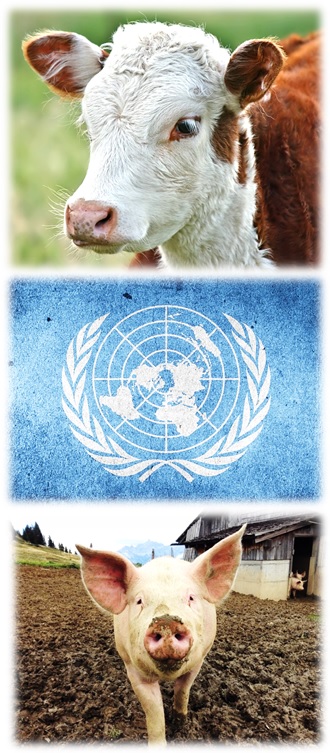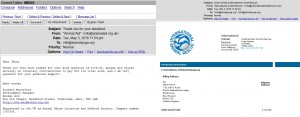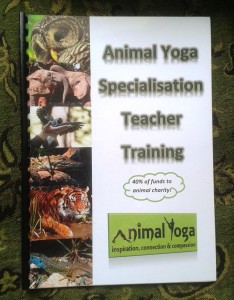 Is animal welfare really now on the global agenda?
Is animal welfare really now on the global agenda?
On 17th October 2016 at the World Food Security meeting in Rome, the United Nations (UN) introduced policy recommendations1 regarding the incorporation of animal welfare into world-wide animal agriculture practices. What does this actually translate to in reality? Are more countries now to draft animal welfare legislation or create action plans to ensure a certain global level of animal welfare? Can we now all put our feet up and rest assured that all farm animals will live happily and die painlessly? Let’s take a look…
There is no doubt that the adoption of these policy recommendations is a significant step forward for increasing animal welfare levels globally, as indicated by the welcome reception from animal welfare charities such as Compassion in World Farming (CIWF) and World Animal Protection. The recommendations cite the so-called Five Freedoms – a set of five basic provisions for ensuring better animal welfare – also utilised by The World Organization for Animal Health. As there is not yet an agreed-upon global definition of good animal welfare2 these recommendations have the potential to begin the process of forming such an international definition that favourably comprises the three-pronged approach to animal welfare (considering physical health; affective states; and natural behaviours and a natural environment3). Moreover, they could assist animal welfare charities in speaking authoritatively when working with decision makers and policy makers in other countries.
Despite these positives, I see the following limitations:
- Animal welfare is not treated as a stand-alone topic but under the umbrella of world food security and nutrition. This diminishes its clout and the recognition of its independent importance.
- I believe UN reform is required before the UN can yield substantial influence; more than a decade has passed since the UN’s publication of Livestock’s Long Shadow4 detailing the negative impacts of the livestock industry, yet world animal product consumption is predicted to only increase if there continues to be little action on this matter5.
- Intensive and confinement animal agricultural systems – which always compromise animal welfare6 – are not explicitly discouraged, and there seems to be inconsistency regarding UN recommendations. For example, in 2010 the UN urged a global shift to a plant-based diet7, and in 2015, a UN Special Rapporteur8 promoted a shift from current industrial practices to agroecology. These two previous recommendations are neither congruent with each other nor with the latest recommendations that this post concerns.
- There are some weaknesses of using the Five Freedoms in the recommendations. For example, they can fail to record instances of poor welfare that only manifest in apparent symptoms over the long-term (such as chickens experiencing severe walking difficulties due to joint infections resulting from the intense speed at and extent to which many are forced to grow9, 10). Even in the UK (known to have some of the most robust animal welfare laws globally11), many harmful acts still continue as they are seen as ‘unavoidable’6 (p.4). I reject the claim that any of the human-imposed harms are unavoidable.
It is a shame that intensive and confinement systems are still being given the green light; CIWF details several alternatives12 that satisfy the One Health concept and necessitate eating less but better animal products. Such alternative methods could even act as a stepping stone to the ultimate potential transition to a vegan world; if people ate significantly less animal produce, there would still need to be considerable shifts towards plant-based diets, and only decentralized and local animal farming would continue, meaning people would be more exposed to the realities of what is involved at every stage. Rhys Southan13, a farmer, offers further insight into this perspective.
Until governments act on the obligations people feel towards animals14 and until animals are elevated to being part of society as suggested by some sociologists15, they will not be given priority over profit; despite increasing legal recognition of animal sentience6, 16, 17, they are legally still regarded as commodities18 and their welfare seems to only be important if it is convenient.
So, yes; the UN’s policy recommendations on animal welfare are fantastic news, especially due to the modern globalisation of agribusiness19, and it means animal welfare will receive a greater platform internationally. However, we need to avoid complacency in our efforts to increase animal welfare world-wide and to ensure the general public is aware of the continuing journey. A complementary next step would be for the UN to ratify The Universal Declaration of Animal Welfare, which would definitely highlight animal welfare as a stand-alone topic, would significantly increase the standards for animal welfare and has the support of over two million signatories already. Please add your signature here.
References
1) Committee on World Food Security (2016). Making a Difference in Food Security and Nutrition – Proposed Draft Recommendations on Sustainable Agricultural Development for Food Security and Nutrition, Including the Role of Livestock. Available at: http://www.fao.org/3/a-mr322e.pdf [accessed 27 Oct. 2016].
2) Favre, D. (2016). An international treaty for animal welfare. Animal Law and Welfare – International Perspectives, 53 (of the series Ius Gentium: Comparative perspectives on law and justice), 87-106. Available at: http://link.springer.com/chapter/10.1007/978-3-319-26818-7_5 [accessed 27 Oct. 2016].
3) Fraser, D. (2008). Understanding animal welfare. Acta Veterinaria Scandinavica, 50 (Supp. 1), [online]. Available at: http://actavetscand.biomedcentral.com/articles/10.1186/1751-0147-50-S1-S1 [accessed 26 Oct. 2016] doi:10.1186/1751-0147-50-S1-S1.
4) FAO (2006). Livestock’s Long Shadow: Environmental Issues and Options. Available at: http://www.fao.org/docrep/010/a0701e/a0701e00.HTM [accessed 29 Oct. 2016].
5) The High Level Panel of Experts on Food Security and Nutrition (2016). Sustainable Agricultural Development for Food Security and Nutrition: What Roles for Livestock? Legg, W. (ed.). Available at: http://www.fao.org/fileadmin/templates/cfs/Docs1516/cfs43/Pres/CFS43_SADL.pdf [accessed 26 Oct. 2016].
6) FAWC (2011). Economics and Farm Animal Welfare. Available at: https://www.gov.uk/government/uploads/system/uploads/attachment_data/file/324964/FAWC_report_on_economics_and_farm_animal_welfare.pdf [accessed 23 Oct. 2016].
7) UNEP (2010). Assessing the Environmental Impacts of Consumption and Production – A Report of the Working Group on the Environmental Impacts of Products and Materials to the International Panel for Sustainable Resource Management. Hertwich, E., van der Voet, E., Suh, S., Tukker, A., Huijbregts, M., Kazmierczyk, P., Lenzen, M., McNeely, J. and Moriguchi, Y. (eds.). Available at: http://www.unep.org/resourcepanel/Portals/24102/PDFs/PriorityProductsAndMaterials_Report.pdf [accessed 31 Oct. 2016].
8) United Nations Human Rights (2015). Climate change poses major threat to food security, warns UN expert. Available at: http://www.ohchr.org/EN/NewsEvents/Pages/DisplayNews.aspx?NewsID=16702&LangID=E [accessed 03 Nov. 2016].
9) Webster, J. (2016). Animal Welfare: Freedoms, Dominions and “A Life Worth Living”. Animals, 6 (35), [online]. Available at: https://pdfs.semanticscholar.org/3619/8539a0785ce3c7dd1db2b9fdb0946aa4e097.pdf?_ga=1.88867544.290997389.1478182658 [accessed 29 Oct. 2016].
10) Welfare Quality (n.d.). Preventing Lameness in Broiler Chickens. Available at: http://www.welfarequalitynetwork.net/network/53490/7/0/40 [accessed 29 Oct. 2016].
11) World Animal Protection (2016). Animal Protection Index. Available at: http://api.worldanimalprotection.org/# [accessed 18 Oct. 2016].
12) CIWF (2016). Fair Food and Farming: The Way Forward. Available at: https://www.ciwf.org.uk/media/7428911/ciwf_uncharter_english_web.pdf [accessed 27 Oct. 2016].
13) Southan, R. (2014). Farm confessional: I raise livestock and I think it may be wrong. 05 Feb. Available at: http://modernfarmer.com/2014/02/farm-confessional-raise-livestock-think-may-wrong/ [accessed 25 Oct. 2016].
14) Welfare Quality Network (2007). Consumers’ Views about Farm Animal Welfare: Part I – National Reports Based on Focus Group Research. Miele, M. and Evans, A. (eds.). Available at: http://www.welfarequality.net/everyone/43215/7/0/22 [accessed 28 Oct. 2016].
15) Matsuoska, A. and Sorenson, J. (2013). Human consequences of animal exploitation: Needs for redefining social welfare. Journal of Sociology & Social Welfare, 40 (4), article 3. Available at: http://scholarworks.wmich.edu/jssw/vol40/iss4/3/ [accessed 15 Oct. 2016].
16) European Commission (n.d.). Animal welfare. Available at: http://ec.europa.eu/food/animals/welfare_en [accessed 28 Oct. 2016].
17) Parliamentary Council Office (n.d.). Animal welfare amendment bill. Available at: http://www.legislation.govt.nz/bill/government/2013/0107/latest/DLM5174807.html?path=bill%2fgovernment%2f2013%2f0107%2flatest&col=bill&fid=DLM5174807&search=sw_096be8ed81047b83_sentient_25_se&p=1 [accessed 28 Oct. 2016].
18) Wilkie, R. (2015). Animals as sentient commodities. In: Kalof, L. (ed.) The Oxford Handbook of Animal Studies. Oxford, Oxfordshire, UK: Oxford University Press. [online]. Available at: http://oxfordindex.oup.com/view/10.1093/oxfordhb/9780199927142.013.16 [accessed 29 Oct. 2016].
19) Park, M. and Singer, P. (2012). The globalization of animal welfare: More food does not require more suffering. Foreign Affairs, 91 (2), 122-133. Available at: http://www.jstor.org/stable/23217226 [accessed 26 Oct. 2016].
Image sources as follows (via Google Images with full usage rights):
Pig image: https://pixabay.com/static/uploads/photo/2016/10/04/10/44/pig-1713996_960_720.jpg<br />
UN logo image: https://pixabay.com/static/uploads/photo/2016/02/07/05/01/united-nations-1184119_960_720.jpg<br />
Calf image: https://upload.wikimedia.org/wikipedia/commons/f/ff/Hereford_Calf_Portrait,_SC,_Vic,_13.10.2007_edit.jpg








